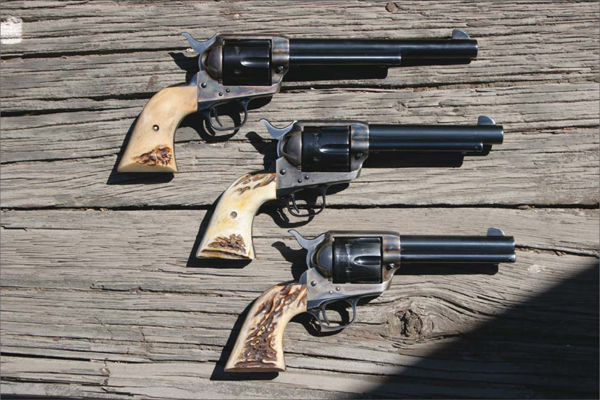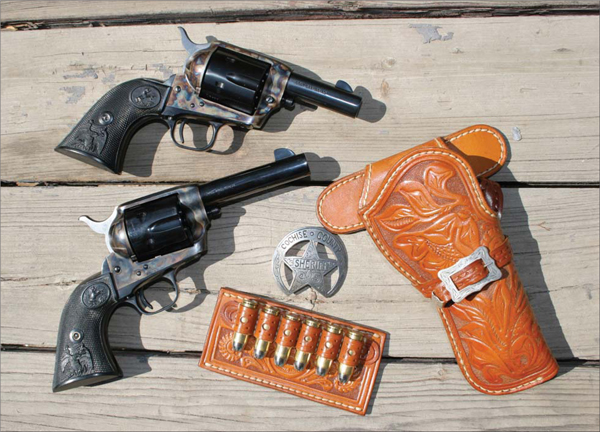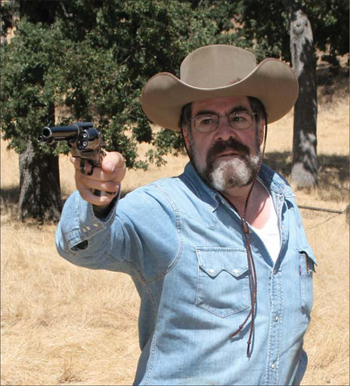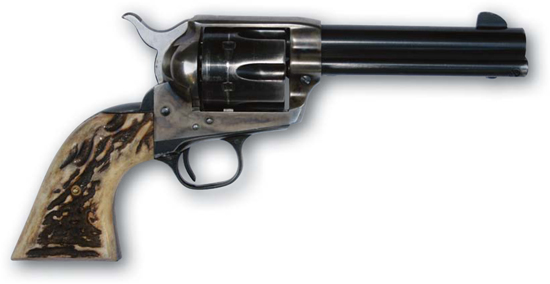50 Famous Firearms You've Got to Own: Rick Hacker's Bucket List of Guns (2015)
COLT SINGLE ACTION ARMY

The Single Action Army is the quintessential “cowboy gun,” and has been seen in practically every western ever filmed. The top gun is stamped “S” over its serial number, to denote ownership by Stembridge Studios, which supplied many such sixguns for the “B” westerns of the 1930s and ’40s. The bottom gun is a current third generation SAA in nickel finish—still a favorite with producers of westerns, although today you are more likely to see Italian replicas being used due to their lower costs. The classic “B” western buscadero rig, such as worn by many silver screen stars, has been authentically replicated by Jim Lockwood of Legends in Leather (www.legendsinleather.com).
Without a doubt, the Colt Single Action Army—or the “Colt New Model Army Metallic Cartridge Revolving Pistol,” as the SAA was initially called, or Model P, as it was originally designated by the factory—has become one of the most recognized, collectable and, dare I say, legendary firearms in the world. Perhaps the greatest testimony to its immortality is the fact that, although its design has been copied by numerous manufacturers in America and abroad, this venerable sixgun is still being manufactured in the USA by the same company that introduced it more than 140 years ago.

A classic Single Action Army, with blue and case hardened finish, 43⁄4-inch barrel, and aftermarket, one-piece steer horn grips.

The three standard barrel lengths of the Single Action Army are (top to bottom): 71⁄2, 51⁄2, and 43⁄4 inches.
The years after the Civil War ended saw Colt’s emerge as the acknowledged revolver manufacturer in America, with two clear winners under its belt, the 1860 Army and the 1851 Navy. But times were changing, and the self-contained metallic cartridge loomed on the horizon, thus dooming the opened-topped revolver design. Cartridge conversions were only a temporary fix. A new sidearm was needed, one adapted to the Army’s dictum for a .45-caliber bore diameter.
Interestingly, the Single Action Army was originally developed as a .44-caliber handgun, as the Army’s official sidearm at the time was the .44-caliber Colt 1860 cap-and-ball. Plus the Ordnance Department had already given a cursory nod, though without officially adopting it, to the Smith & Wesson No. 3 First Model (also known as the American), which was chambered in .44 S&W Russian. Thus, Colt factory superintendent William Mason assumed the government preferred the .44 designation. But adopting the philosophy that bigger is better, at the last minute the Army decided that what it really wanted was a .45-caliber sidearm. It turned out to be a fortuitous move for the Single Action Army, as the .45 Colt cartridge provided the perfect combination of balance and firepower, a fact that became immediately apparent and appreciated by cavalry troopers during the Indian Wars. Its only drawback was that cartridges had to be loaded and ejected one at a time, an operation that required two hands—a difficult feat at best while astride a galloping horse.

The three-inch barreled Sheriff’s Model (top) and four-inch Storekeeper (bottom) are still made occasionally by the factory as limited editions. Both are prized by collectors and shooters alike, even though they don’t have ejector rods underneath their barrels and, thus, require special frames. Note the “smokeless” frame on top and the “blackpowder” frame on the bottom.

The author regularly packs a Single Action Army when hunting, hiking, or camping, for informal plinking or an impromptu opportunity to bag something for the pot. It’s also a good deterrent for predators.

Two third generation SAAs (top) in nickel finish and (bottom) blued and case hardened. Both are classic representatives of the Old West and are still rugged and reliable handguns today.
Nevertheless, in the autumn of 1872, after beating out six other revolver manufacturers, including Smith & Wesson, Merwin & Hulbert, and Remington, the U.S. Ordnance Department selected the Colt Single Action Army as the government’s official sidearm, with an initial order for 8,000 guns. This number would eventually climb to 39,063 Single Action Armies ordered by the government by 1892, when the SAA was replaced with the 1892 Colt Army and Navy Model double-action .38. Even then, the SAA remained a far superior weapon, even though it had to be manually cocked for each shot.
Thanks to the inventive adaptations of Colt’s engineer Charles B. Richards and factory superintendent William Mason, the SAA was a culmination of the many Colts that had come before it. The topstrap was adapted from Colt’s 1855 Sidehammer. The plow handled backstrap and trigger guard came from the 1851 Navy, which had, in turn, lent it to the 1871 Open Top. Likewise, the initial 71⁄2-inch barrel length also came from the Navy. But the internal cocking mechanism had its origins with the 1848 Walker. Of course, increased advances in metallurgy enabled the Single Action Army to weigh in at a respectable 21⁄2 pounds, substantially less than the massive, large-caliber, 41⁄2-pound Dragoon horse pistols of a few decades earlier. In fact, the SAA is one of the best-balanced handguns ever produced, a fact not lost on the trick shooters of early Wild West shows and, later, the silver screen. And not only was it reliable and rugged, if need be, it could be fired with half its parts broken or missing.

This is one of the author’s original SAAs, a second generation gun that was purchased new and outfitted later with tea-stained stag horn grips.

The Single Action Army was the official sidearm of the United States Army, from 1873 until 1892. It is shown here in the 51⁄2-inch barreled Artillery Model (top) and the original 71⁄2-inch Cavalry Model, (bottom), although these are collector’s terms; the guns weren’t called that by the factory.
Another thing the Single Action Army had going for it was its perfect pairing with its propriety cartridge, the .45 Colt. Packed with 40 grains of blackpowder (the same charge previously used in the mighty Colt Dragoon), and pushing a 255-grain bullet out the muzzle at 810 fps, this was a formidable round, especially when one considers that the 1860 Army (of which many were still in use) only fired a 28-grain charge of powder behind a 133-grain round ball. Needless to say, the Single Action Army proved to be a much more potent man-stopper.
Like many other military guns, the SAA was immediately embraced by the civilian population as well. In fact, one major firearms distributor, B. Kittredge & Company, of Cincinnati, dubbed the new sixgun “The Peacemaker,” borrowing a nickname that had been attributed to Samuel Colt many years earlier. Throughout its existence, the SAA garnered other sobriquets, too, including Thumbuster, Hogleg (referring to the 71⁄2-inch barreled version), and my favorite, Judge Colt and His Jury of Six (although this sixshooter was in reality a five-shooter; with its fixed firing pin, the hammer was always kept resting on an empty chamber, lest the gun be accidently discharged should it be dropped).
The initial finish was blue, with a handsome bone charcoal case hardened frame and hammer. Grips were one-piece walnut, then later offered in black checkered gutta-percha. Owing to its civilian popularity, a nickel finish was soon brought out. In 1875, a 51⁄2-inch barrel was introduced, which collectors have since dubbed the “Artillery Model.” During the Philippine Insurrection, a number of retired 71⁄2-inch barreled “Cavalry Models” were cut down to 51⁄2-inch barrels and re-issued to troops who discovered that the .45-caliber single action was far more effective in dealing with adrenalin-pumped Moro warriors than the standard issue double-action Colt New Army & Navy. A 43⁄4-inch barrel, called the “Civilian Model” by collectors, came out in 1879.
Colt’s offered non-standard barrel lengths, charging a dollar an inch for anything over the “Cavalry” length. Single Action Armies with factory barrels as long as 18 inches and as short as two inches, although rare, are known to exist. Many stretch-barreled SAAs were fitted with long-range sights and often came with detachable shoulder stocks. Barrel lengths less than 43⁄4 inches did not have ejector rods, and the most notable variations of these are (using collector’s terms, as the factory never referred to the guns as such) four-inch Storekeepers and three-inch Sheriff’s Models. But, as noted Colt collector and author, the late James Serven, once wrote in his classic book, Colt Firearms, “I doubt that any self respecting sheriff would arm himself with a Single Action Army Colt with a 3” barrel.”
In 1878, Colt’s secured its place in the annals of frontier Americana by chambering its Single Action Army for the .44-40, which was achieving an immortality of its own in Winchester’s 1873 rifle and carbine. Thus, for the first time since the .44 rimfire was chambered for both the Henry Rifle and the 1871 Open Top, a frontiersman could carry the same box of cartridges for rifle and pistol—and the centerfire .44-40 could be reloaded. This chambering became so popular that .44-40 Colt single-actions were designated as the Frontier Six Shooter, a moniker that was etched, and later roll-stamped on their barrels.
Next in line for single-action chamberings were the .38-40 and .32-20, and Winchester acknowledged the single-action’s reputation by following suit with identical chamberings for its lever-actions. These three calibers, along with the .45 Colt (which was so popular the gun was often called a “Colt .45” no matter what bullet it fired), comprised the most popular SAA calibers. I have since dubbed them “The Holy Trinity.” However, due to the adaptability of its design, the Peacemaker was eventually chambered for no less than 41 different cartridges, ranging from .22 rimfire to the massive .476 Eley.
Around 1892 the method for retaining the cylinder base pin was changed from a frame-mounted screw to a spring-loaded pushpin. Many have erroneously assumed that this marked the switch from blackpowder, but it wasn’t until 1900, starting with serial No. 192,000, that the factory warranted its single-actions for smokeless powder. In addition to 976 flat-top target models, from 1894 until 1915, 44,350 Bisley target versions were produced. The SAA also proved a ready canvas for the engraver’s artistry. Approximately 3,500 factory engraved pre-war guns were produced and have become highly valuable collector’s items. But its antiquated design, the Great Depression, and World War II all combined to halt production of the SAA in 1941, with 357,859 guns having been manufactured.
In 1947, Colt’s Manufacturing Company announced in The American Rifleman that it would not be resuming production of its famed Single Action Army. But the popularity of TV westerns and the resultant sport of fast draw resulted in the old Thumbuster being resurrected in 1955, in what collectors now call “second generation Colts.” With a brief hiatus in 1975 to update machinery (to produce what has become known as “third generation guns”), the Peacemaker remains in production to this day.
Like many baby boomers, my fascination with the Colt single-action began at an early age, while watching it perform multi-shot miracles (far exceeding its six-shot cylinder capacity) on the silver screen and, later, television in the hands of cowboy heroes such as Hopalong Cassidy, Gene Autry, and Roy Rogers. Later on, I would salivate over the sixgun on back-to-back TV westerns such as Gunsmoke, Have Gun-Will Travel, and 26 Men.
I remember my first SAA, a pre-war .45 with a 43⁄4-inch barrel and stag grips and an Arvo Ojala holster that I bought from a down-and-out acquaintance for $65. I have since acquired numerous other Single Action Armies since then, because, like good days in the saddle, you can never have too many of them.
The only irony is that Sam Colt never lived to see the most famous gun his company had ever produced. He died on January 10, 1862, 11 years before the Single Action Army was born.